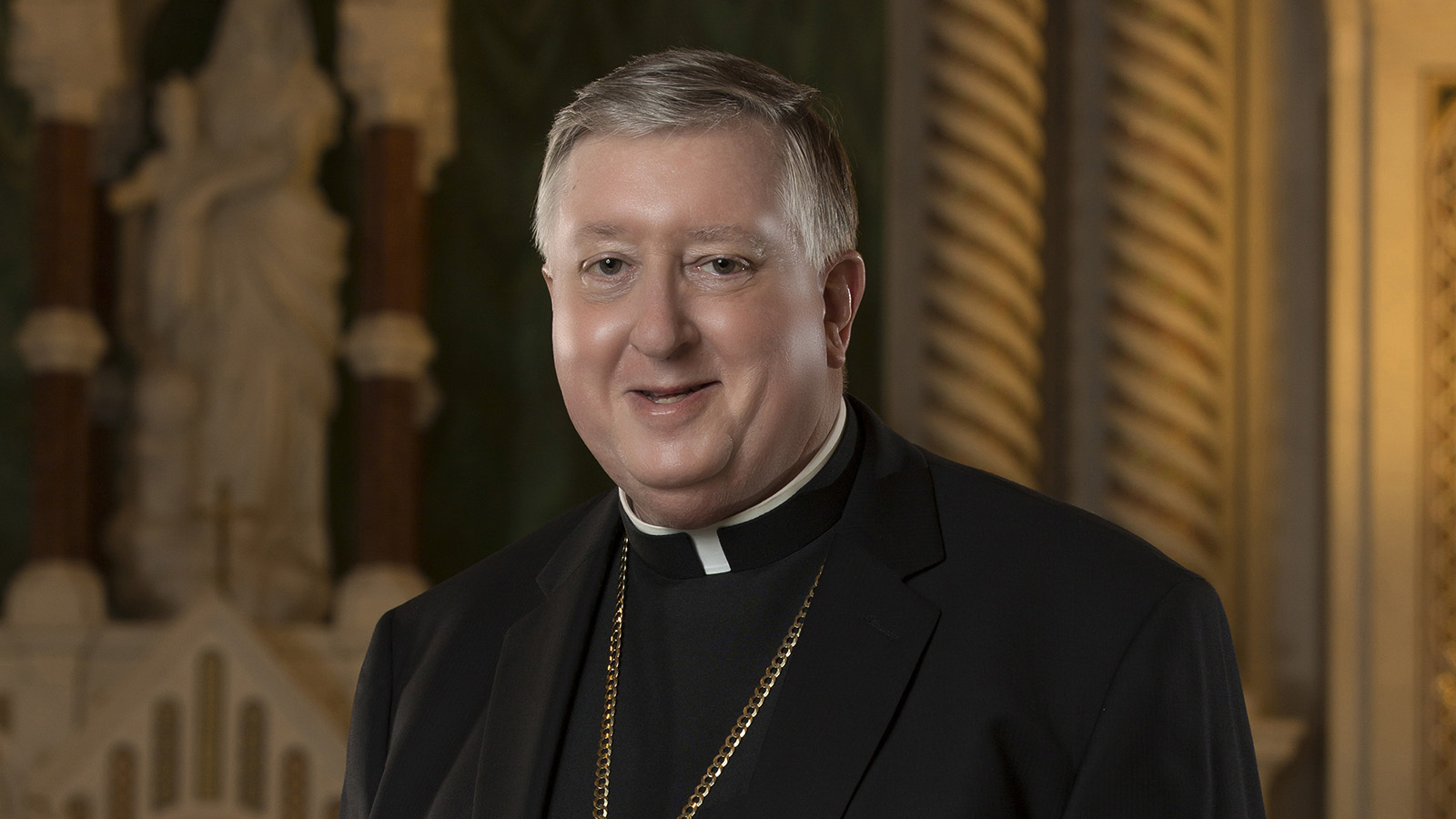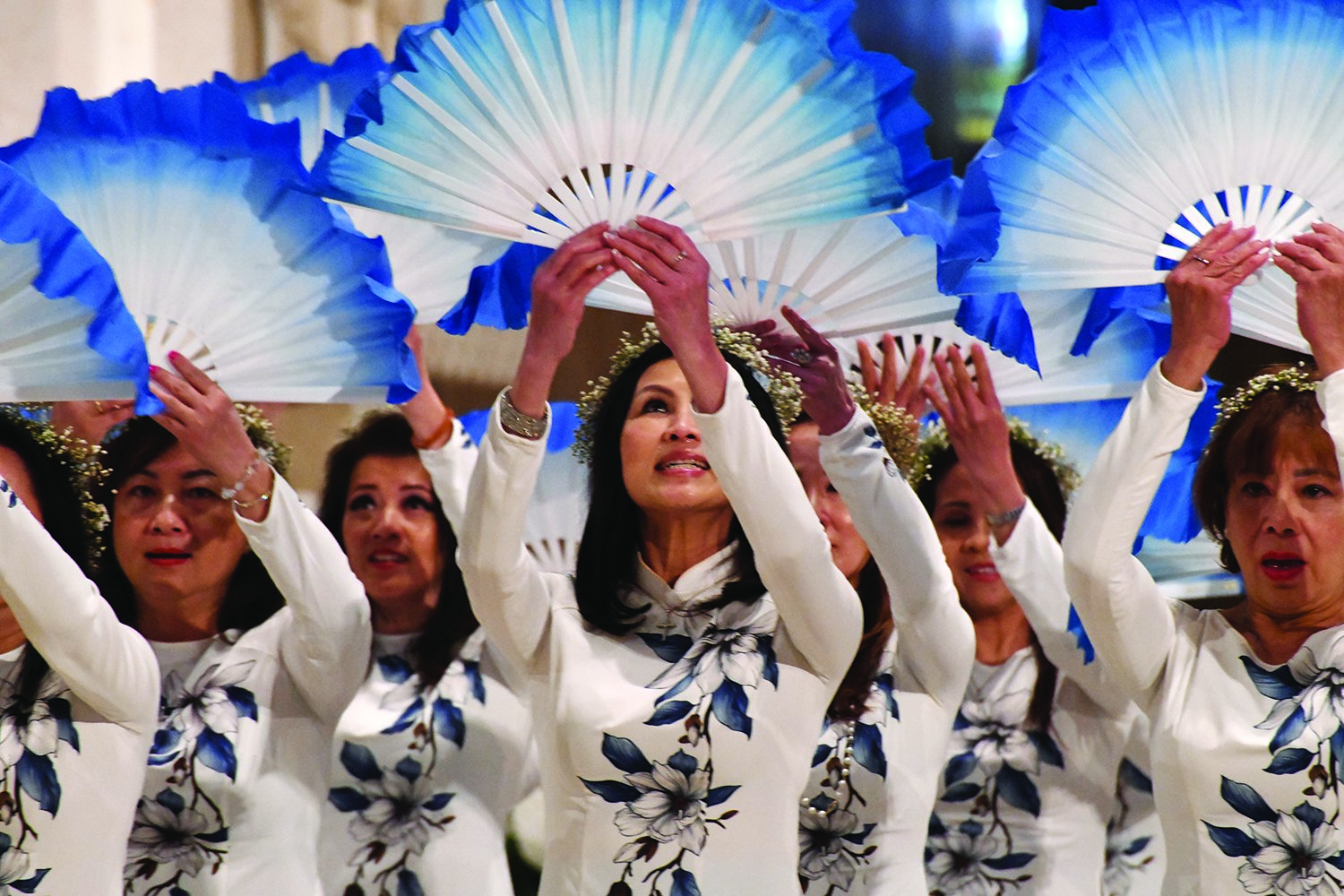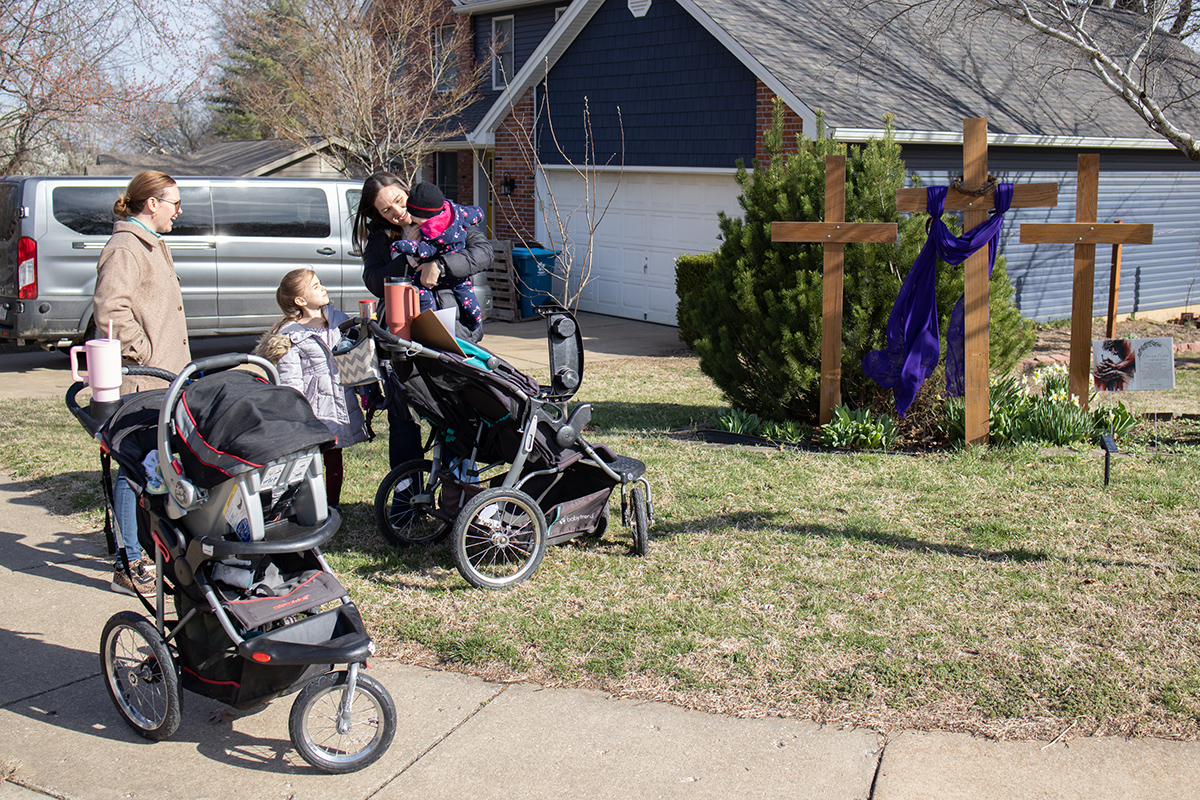May is a month to honor our Blessed Mother and her role in the redemption of mankind

A woman of many titles, Mary has one central role in the life of the Church
She’s the Mother of God. The New Eve. Mediatrix of Graces. Stella Maris. The Queen of Heaven.
There are many titles for our Blessed Mother, but she has a unique role in helping us understand and grow closer to Our Lord. The Church places importance on the angels and saints in heaven, but no one in that realm quite lives up to our Blessed Mother.
Catholics honor Mary in May with special devotions, such as praying the Rosary or holding May crowning ceremonies at Catholic schools. These aren’t acts of worship, but of devotion, ways for us to highlight her important role in salvation history and better understand who she was in relationship with our Lord.
So why did God choose Mary to bring His Son into the world? It’s because of the fittingness of how God has chosen to redeem mankind — to become man Himself, said Msgr. Eugene Morris, who is completing a doctorate in Mariology from the International Marian Research Institute at the University of Dayton, Ohio and serves as rector of the Oratory of Sts. Gregory and Augustine.
“We (humans) are the ones who have introduced sin into the world,” Msgr. Morris said. “There’s always been a necessity for reparation for our sins, but only God will ultimately pay the price for the offenses against Him. Until the sacrifice of our Lord, we wouldn’t have been able to come up with anything as fitting.” It makes sense then that God would become man by being born of a woman.
The Church has numerous dogmatic teachings about Mary, but we also can learn quite a bit about her from Scripture, dating from the Old Testament. Genesis offers us the first veiled prophecy foreshadowing the coming of Mary and Jesus:
“I will put enmities between thee (the serpent) and the woman, and thy seed and her seed: She shall crush thy head, and thou shalt lie in wait for her heel” (Genesis 3:15).
“Here He had already prepared for a woman who would crush the head of the serpent,” Msgr. Morris said. “That woman from all time has been our Blessed Mother.”
And of course, there’s the famous passage from Isaiah, which states: “Therefore the Lord Himself shall give you a sign. Behold a virgin shall conceive and bear a son, and His name shall be called Emmanuel.” (Isaiah 7:14).
The more we grow in our understanding of the revelation of Jesus, that light has been shed in a particular way upon our Blessed Mother and the uniqueness of her role, Msgr. Morris said.
“We are all apostles and adopted children of God, we’re all redeemed, but only one person for all of eternity is going to be the Mother of God,” he said. “To look at our teachings and understand them is to really come to a deeper understanding of Christological reality.”

>> Mary’s predestined role as the Mother of God
When God sent forth His Son Jesus, He wanted the free cooperation of another human. For the mother of His Son, He chose a daughter of Israel, a young Jewish woman of Nazareth in Galilee, “a virgin betrothed to a man named Joseph, of the house of David, and the virgin’s name was Mary” (Luke 1:27).
The Catechism of the Catholic Church notes that “From among the descendants of Eve, God chose the Virgin Mary to be the mother of His Son. ‘Full of grace,’ Mary is ‘the most excellent fruit of redemption’ (Sacrosanctum Concilium 103); from the first instant of her conception, she was totally preserved from the stain of original sin and she remained pure from all personal sin throughout her life” (CCC 508).
Mary’s divine motherhood was declared at the Council of Ephesus in 431. The council formalized Mary as “theotokos,” or the “Mother of God” in Greek.
Interestingly enough, there is a shrine in Ephesus (modern day Turkey), where the Blessed Mother is said to have lived her last days with St. John, the beloved disciple. Several popes have visited the site, including St. John Paul II and Pope Benedict XVI.
>> The Immaculate Conception of Mary
Mary was without sin from the moment she was conceived in her mother’s womb. We celebrate the feast of the Immaculate Conception — Mary’s conception by St. Anne — on Dec. 8. It is a holy day of obligation in the Church.
Pope Pius IX declared the Immaculate Conception a dogmatic teaching of the Church in 1854: “The most Blessed Virgin Mary was, from the first moment of her conception, by a singular grace and privilege of almighty God and by virtue of the merits of Jesus Christ, Savior of the human race, preserved immune from all stain of original sin.”
By preserving Mary from the guilt of original sin, God made Mary worthy and well-disposed to be the mother of our Savior.
>> The Annunciation
The Annunciation to Our Blessed Mother is the moment when the Archangel Gabriel visited the Blessed Mother to tell her that she would become the mother of Jesus, Son of God. The feast is usually observed on March 25, nine months before the birth of Jesus on Christmas.
In the Gospel, the Archangel Gabriel greets Mary as “full of grace.” The Greek word that is translated as “full of grace” (“kecharitomene” in Greek) is not found anywhere else — not only in Scripture, but in any ancient sources. Like Mary, the term is unique in history. The Annunciation is about God the Son’s humility in becoming Incarnate in the womb of Mary, and Mary’s humble acceptance of God’s will for her life.
At the announcement that she would give birth to “the Son of the Most High” without knowing man, by the power of the Holy Spirit, Mary responded with an obedience of faith: “Behold, I am the handmaid of the Lord. May it be done to me according to your word.” (Luke 1:38).
>> Mary’s Virginity
Another of the Church’s dogmatic teachings is that Jesus was conceived by the power of the Holy Spirit in the womb of a virgin. References have been made throughout Church history; the Council of the Lateran in 649 declared that Mary conceived “without any detriment to her virginity, which remained inviolate even after His birth.”
The Catechism notes that the “Gospel accounts understand the virginal conception of Jesus as a divine work that surpasses all human understanding and possibility,” and that Christ’s birth “did not diminish his mother’s virginal integrity but sanctified it. … The liturgy of the Church celebrates Mary as ‘Aeiparthenos,’ the ‘ever-virgin.’” (CCC 497, 499).
“For it is through the holy Spirit that this child has been conceived in her,” the angel said to Joseph about Mary, his fiancee (Matthew 1:20).
The Church also sees this as a fulfillment of the divine promise given through the prophet Isaiah: “Therefore the Lord Himself shall give you a sign. Behold a virgin shall conceive and bear a son, and His name shall be called Emmanuel.” (Isaiah, 7:14).
>> Mary’s Assumption
We believe that at the end of her earthly life, Mary was assumed into heaven — body and soul. The feast of the Assumption is observed on Aug. 15, a Holy Day of Obligation in the Church.
Pope Pius XII declared Mary’s Assumption as a dogmatic teaching of the Church in his encyclical, “Munificentissimus Deus,” on Nov. 1, 1950: “The Immaculate Mother of God, the ever Virgin Mary, having completed the course of her earthly life, was assumed body and soul into heavenly glory.”
While the event is not explicitly related in Scripture, Pope Pius XII defined it as “divinely revealed.” It belongs to the deposit of faith, consistently believed since apostolic times.
In the preface for the solemnity of the Assumption, there is a beautiful prayer offered by the priest at Mass:
“For today the Virgin Mother of God was assumed into heaven as the beginning and image of your Church’s coming to perfection and a sign of sure hope and comfort to your pilgrim people;
“rightly you would not allow her to see the corruption of the tomb since from her own body she marvelously brought forth your incarnate Son, the Author of all life.”
Parishes, chapels and shrines in the Archdiocese of St. Louis that reference Mary

Annunciation, Webster Groves
Annunziata, Ladue
Assumption, New Haven
Assumption, Mattese
Assumption, O’Fallon
Black Madonna Shrine, Eureka
Holy Rosary, Warrenton
Immacolata, Richmond Heights
Immaculate Conception, Arnold
Immaculate Conception, Augusta
Immaculate Conception, Dardenne Prairie
Immaculate Conception, Maplewood
Immaculate Conception, Old Monroe
Immaculate Conception, Park Hills
Immaculate Conception, Union
Immaculate Conception, West Arnold
Immaculate Heart of Mary, New Melle
Immaculate Heart of Mary, south St. Louis
Mary Mother of the Church, Mattese
Mary Queen of Peace, Webster Groves
Our Lady, Festus
Our Lady Help of Christians, Weingarten
Our Lady of Guadalupe, Ferguson
Our Lady of Lourdes, University City
Our Lady of Lourdes, Washington
Our Lady of Providence, Crestwood
Our Lady of Sorrows, south St. Louis
Our Lady of the Holy Cross, north St. Louis
Our Lady of the Pillar, Creve Coeur
Our Lady of the Presentation, Overland
Our Lady of Victory, Sereno
Our Lady Queen of Peace, House Springs
Queen of All Saints, Oakville
Shrine of the Miraculous Medal, Perryville
St. Mary, Hawk Point
St. Mary of Perpetual Help, Moselle
St. Mary of Victories, Downtown St. Louis
Sts. Mary and Joseph Chapel, south St. Louis
The Rosary: A special devotion to our Blessed Mother
The Church honors our Blessed Mother with special devotions. A primary devotion is the Rosary, which has been described as “the compendium of the entire Gospel” by Pope Pius XII.
“By its nature the recitation of the Rosary calls for a quiet rhythm and a lingering pace, helping the individual to meditate on the mysteries of the Lord’s life as seen through the eyes of her who was closest to the Lord,” Pope Paul VI wrote in his 1974 apostolic exhortation, “Marialis Cultus.” “In this way the unfathomable riches of these mysteries are unfolded.”
The U.S. bishops note that the Rosary is a Scripture-based prayer. “It begins with the Apostles’ Creed, which summarizes the great mysteries of the Catholic faith. The Our Father, which introduces each mystery, is from the Gospels. The first part of the Hail Mary is the angel’s words announcing Christ’s birth and Elizabeth’s greeting to Mary. St. Pius V officially added the second part of the Hail Mary. The Mysteries of the Rosary center on the events of Christ’s life. There are four sets of Mysteries: Joyful, Sorrowful, Glorious and — added by St. John Paul II in 2002 — the Luminous.”
Our Blessed Mother’s Rosary and Scapular Program is a special ministry in the Archdiocese of St. Louis that teaches young people and adults how to make and pray a Rosary. For more information, contact Mary Knollmeyer at (314) 434-0115.
Knollmeyer recommended several reading resources on the Rosary, including:
“The Secret of the Rosary,” by St. Louis de Montfort
“Divine Mysteries of the Most Holy Rosary,” by Mary of Agreda (J.M.J. Book Company)
The United States Conference of Catholic Bishops also has resoirces on praying the Rosary. Visit www.bit.ly/2DJntA7.
She’s the Mother of God. The New Eve. Mediatrix of Graces. Stella Maris. The Queen of Heaven. There are many titles for our Blessed Mother, but she has a unique … May is a month to honor our Blessed Mother and her role in the redemption of mankind
Subscribe to Read All St. Louis Review Stories
All readers receive 5 stories to read free per month. After that, readers will need to be logged in.
If you are currently receive the St. Louis Review at your home or office, please send your name and address (and subscriber id if you know it) to subscriptions@stlouisreview.com to get your login information.
If you are not currently a subscriber to the St. Louis Review, please contact subscriptions@stlouisreview.com for information on how to subscribe.







